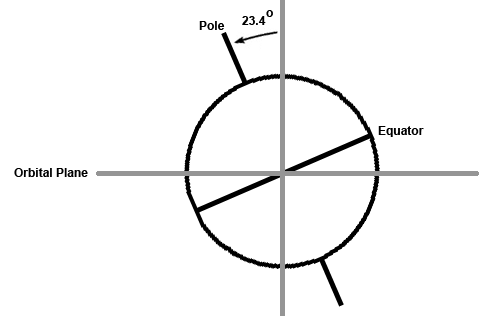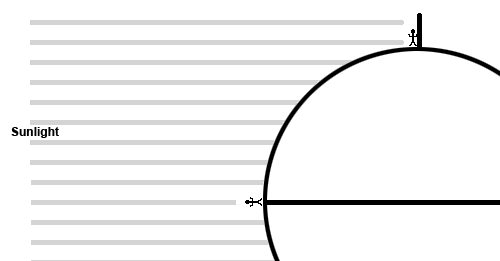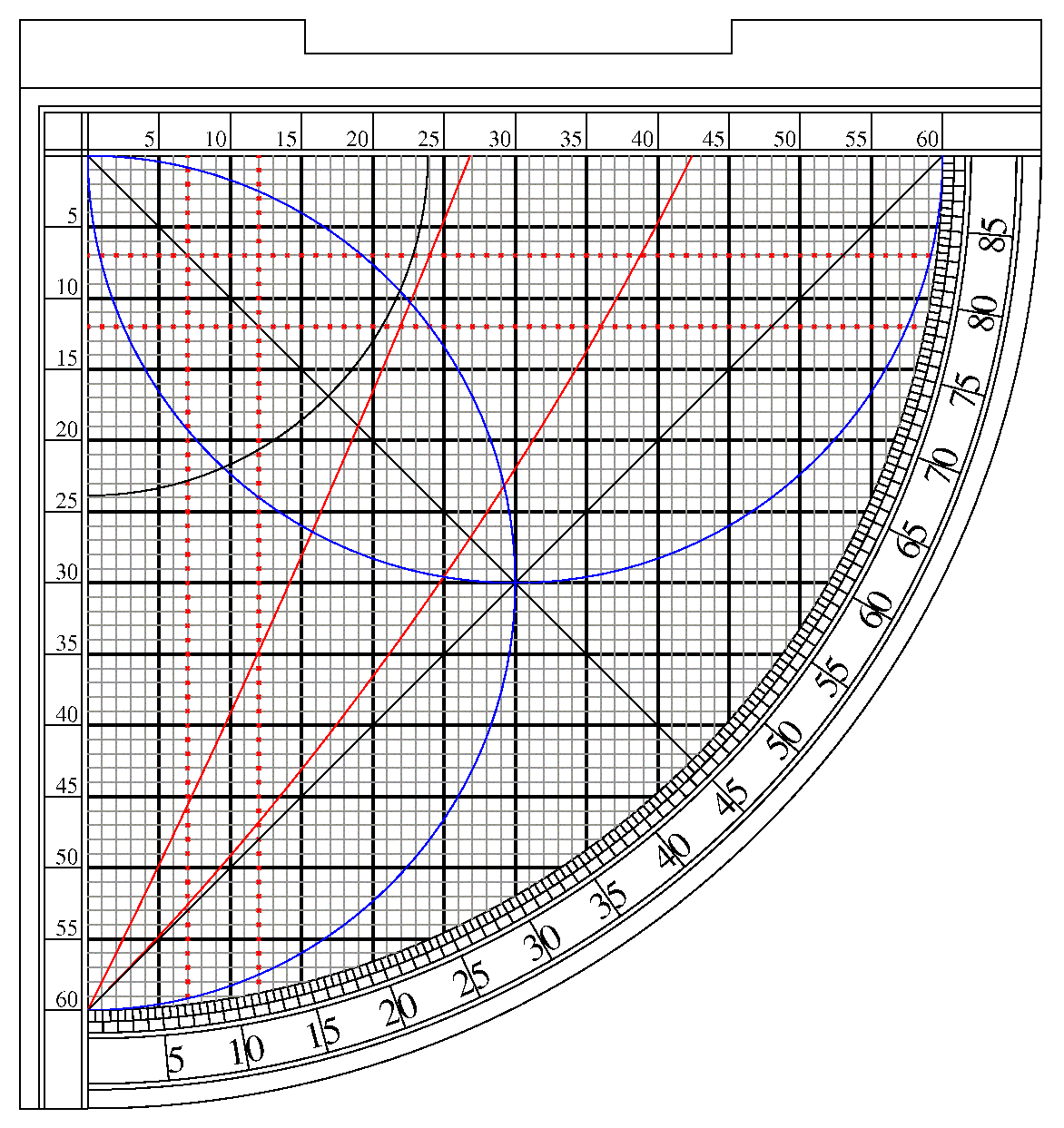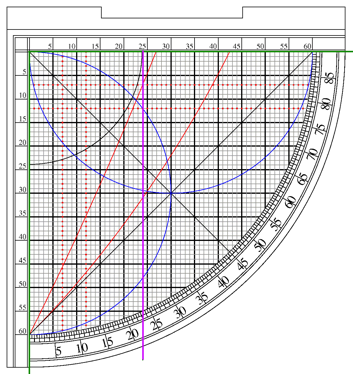Deconstructing the Sine Quadrant-Part 3: The Advanced Functions Continued
- on 02.09.14
- Random Jottings, Sine Quadrant
- Comments Off on Deconstructing the Sine Quadrant-Part 3: The Advanced Functions Continued
In part two we began examining the functionality provided by the various lines and arcs visible on the front of a typical sine quadrant. The use of the sine and cosine arcs was fairly straight-forward, being related to the basic function of the device (converting from angle to sine/cosine and back). Next we are going to examine one of the more complex functions; one that will be very useful in later installments.
Links
The previous installments in this series can be found here:
Part One
Part Two
Printable PDF of the example Sine Quadrant
The Obliquity Arc
Another line found on many examples of the Sine Quadrant is a circular arc centered on the origin point at the quadrant’s right angle. With a radius of approximately 24 units (marked in black on the figure above) this arc is a projection of the Earth’s orbital obliquity (tilt). The purpose of this marking is to allow the user determine the Sun’s declination (angle above or below the equator) for any given day, allowing the user to then determine the sun’s altitude at noon for that day(besides being neat, this will be of use later on: See part four.)
To understand how this works we will need to review a bit of basic astronomy:
The Earth’s axis of spin, and therefore its equator, is tipped 23.4 degrees to the plane of the planet’s orbit.

This means that as the Earth moves around the Sun in the course of a year, the Sun appears to move back and forth over the equator spending time in both the Northern and Southern hemispheres.
Traditionally, the Sun’s path through the sky (the ecliptic) is divided up into 12 30-degree zodiac signs. The Spring Equinox defines the zodiac’s starting point, the “First Point of Aries” (Aries 0), when the sun is directly over the equator getting ready to head north. At this point the day and night are of equal length. Each day the Sun moves a little way along the ecliptic, progressing through the zodiac signs until it returns to its starting place. As the days pass the Sun appears to creep north until the Summer Solstice, when the Sun is at its northern-most point and the day is at its longest. Then the Sun moves back south. The movement of the Sun and the seasons should be familiar to all.
Now look at the following diagram:

At the equinox the sun appears directly above the equator, so for someone standing on the equator, at noon the sun would be directly overhead, at an angle of 90 degrees to the horizon. If another person was standing at the North Pole at the same time, they would see the Sun on the horizon, or at 0 degrees elevation. Therefore, you can compute the angle of the Sun above the horizon for the equinox as:
noonAngle = 90 – lat
When the Sun is at a different part of the ecliptic, it will be up to several degrees north or south of the equator, so the equation becomes:
noonAngle = (90 – lat) + DecSun
Or to put it another way, you can compute the Sun’s noon altitude if you subtract your latitude from 90 and then add the Sun’s declination for that day.
Example: Given you are at 50 degrees north latitude, find the Sun’s noon altitude for the Summer and Winter solstices:
Summer: (90-50) + 23.4 = 63.4 degrees
Winter: (90-50) + -23.4 = 16.6 degrees (remember the Sun has a negative declination in winter/south of the equator)
Returning to our sine quadrant now: How can we determine the Sun’s declination for a given day?
The zodiac is divided up into 360 degrees. Think about it this way: At the Spring Equinox the Sun is 0 degrees on the zodiac; at the Summer Solstice the Sun is at 90 degrees; at the Fall Equinox, 180 degrees; Winter Solstice sees the Sun reach 270 degrees and finally returns to 0 at Spring Equinox again.
Now take the sine quadrant and hold the cord at 0 degrees. Note where it crosses the obliquity line and follow the grid down and read the angle: 0 degrees. Now move the cord to 90 degrees and do the same: you will get an angle of about 23.5 degrees.
At this point reverse the direction you move the cord and move an additional 90 degrees to 180 (the cord is now back at 0). By moving the cord up and back four times you sweep out 360 degrees, and can simulate traversing the entire zodiac. Zero degrees represents the Spring and Fall equinoxes, and 90 degrees represents the Summer and Winter solstices.
So, let us say you want to know the angle of the sun at noon for the 5 of May. If you look up the Sun’s position for that date in your ephemeris (if you needed to use this device you would most likely have one hanging around), you get a figure of Taurus 15. Taurus is the 2nd symbol in the zodiac, so add 15 to 30; this gives us 45 degrees. Move the cord to the proper position, 45 degrees, and mark where it crosses the obliquity arc, follow this point down to the degree scale and read off the Sun’s declination as 16.5. You are still standing at 50 North (from the previous example), so you can compute the Sun’s elevation at noon for that day to be:
(90-50) + 16.5 = 56.5 degrees
So, what if you misplace your ephemeris? Then what? Well, there are 365.25 days in a year, and 360 degrees in a circle. Counting one day per degree only puts us off 5.25 degrees by the end of the year, this would translate to an error in declination of less than two degrees. If we are counting days since the last solstice or equinox, the possible error is only a quarter of that, probably within the observational error of the instrument. So, depending on how important fine accuracy is to you, you might not need an ephemeris at all.
Let’s rework the last example without an ephemeris:
The Spring Equinox is March 20th, therefore the 5 of May is 46 days later. So moving 46 degrees around from 0 (Spring Equinox) we place the cord at 46 and read a declination of 17 for the Sun. This is only slightly off (half a degree) from the figure we got above (16.5).
So. as we have seen, with a little mental calculation, a person can use a sine quadrant to find the angle of the Sun at noon for any day of the year. The obvious next question is why would you need to know? Next week I will be explaining that, and discussing some more of the functions of the sine quadrant.

